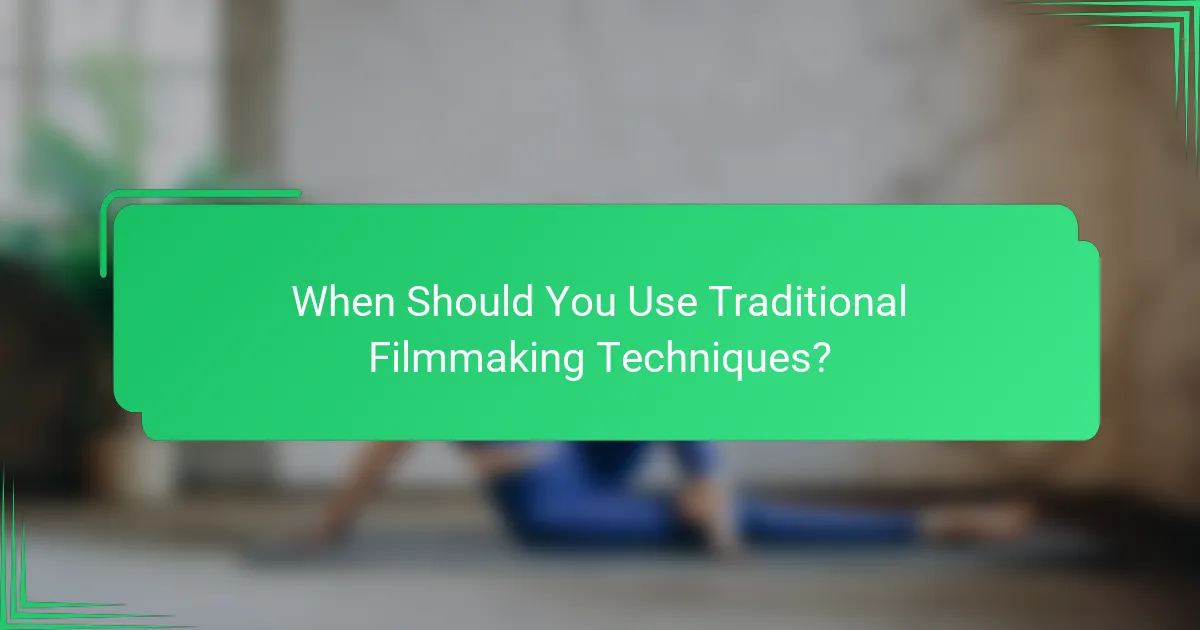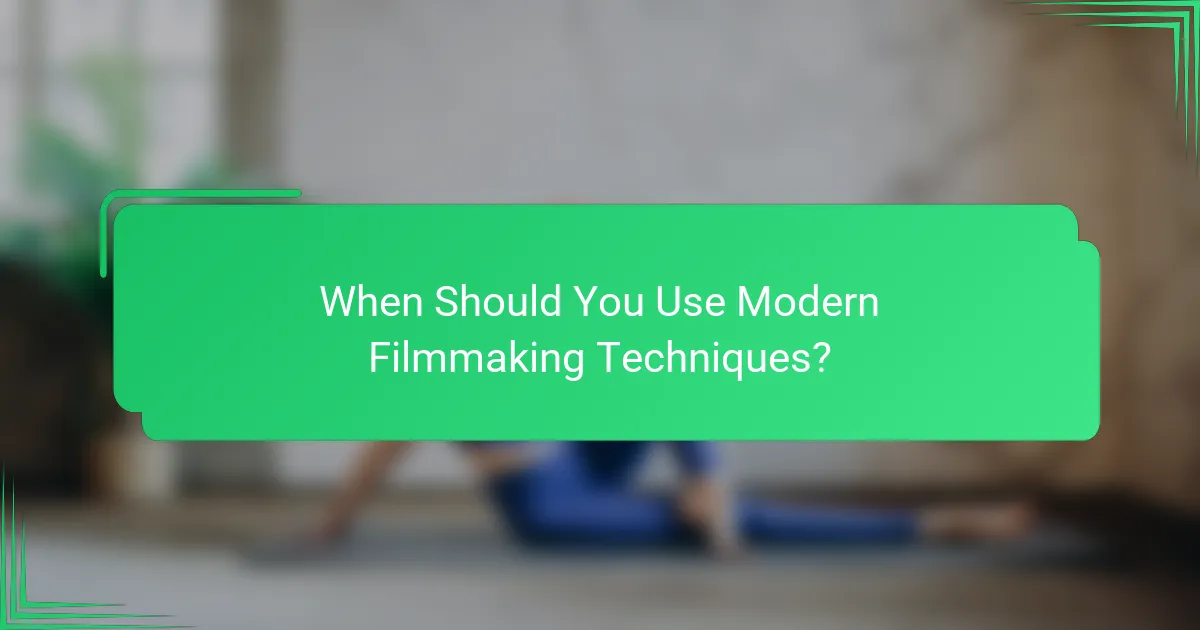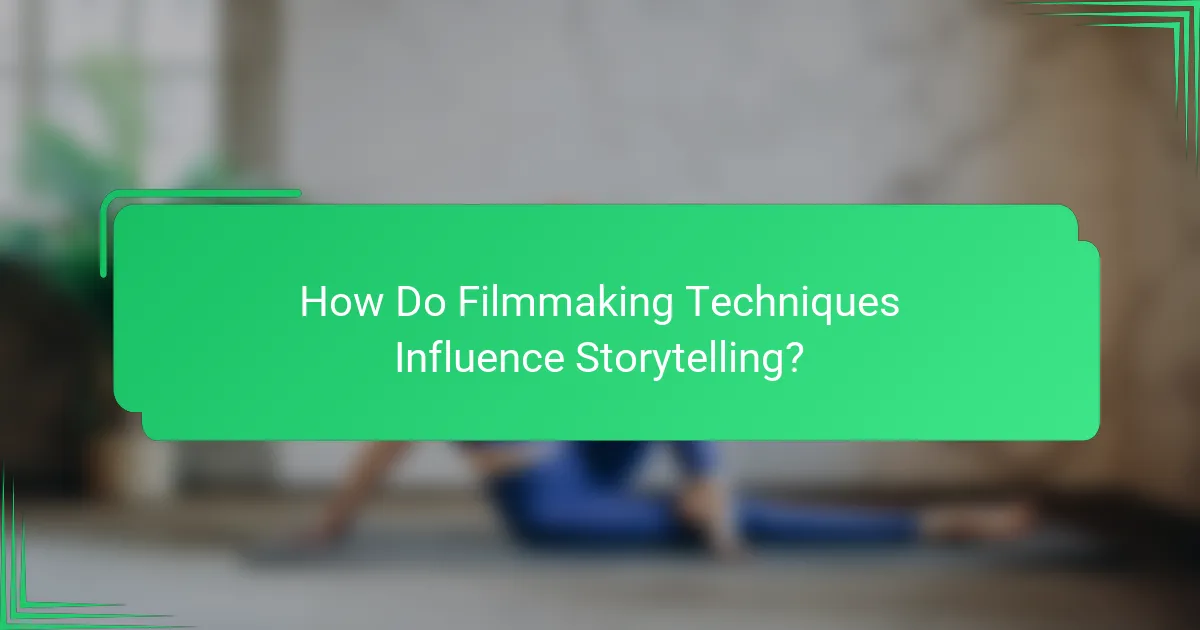In the evolving landscape of cinema, filmmakers often find themselves weighing the merits of traditional versus modern filmmaking techniques. Traditional methods emphasize physical film and manual processes, offering a unique aesthetic and authenticity, while modern techniques harness digital technology for efficiency and enhanced visual storytelling. Understanding when to use each approach can significantly impact the success of a project, depending on its artistic vision and practical requirements.

What Are the Key Differences Between Traditional and Modern Filmmaking Techniques?
Traditional filmmaking techniques rely on physical film and manual processes, while modern techniques leverage digital technology and software. Understanding these differences can help filmmakers choose the right approach based on their project needs and resources.
Traditional techniques focus on physical film and manual editing
Traditional filmmaking involves shooting on physical film stock, which requires careful handling and processing. Manual editing is done by cutting and splicing film reels, a labor-intensive process that demands precision and skill.
This method often leads to a distinct aesthetic, with grain and texture that some filmmakers and audiences prefer. However, it can be time-consuming and costly, as film stock and processing fees add to production expenses.
Modern techniques utilize digital technology and software
Modern filmmaking primarily uses digital cameras and editing software, allowing for greater flexibility and efficiency. Digital files can be easily manipulated, stored, and shared, streamlining the production process.
With advancements in technology, filmmakers can achieve high-quality visuals and sound without the limitations of physical film. This approach also enables quicker turnaround times, making it easier to adapt to changes during production.
Differences in production costs and time efficiency
Production costs for traditional filmmaking can be significantly higher due to the expense of film stock, processing, and manual editing. In contrast, modern techniques often reduce costs by utilizing digital equipment and software, which can be more affordable and accessible.
Time efficiency is another critical factor; traditional methods may require weeks for editing, while digital editing can often be completed in days or even hours. This rapid pace allows filmmakers to meet tight deadlines and respond to audience feedback more effectively.
Impact on storytelling and audience engagement
The choice between traditional and modern techniques can influence storytelling style and audience engagement. Traditional methods may evoke nostalgia and authenticity, appealing to certain demographics who appreciate classic cinema.
On the other hand, modern techniques facilitate innovative storytelling through advanced visual effects and interactive elements, enhancing viewer engagement. Filmmakers must consider their target audience and the emotional impact they wish to create when deciding which techniques to employ.

When Should You Use Traditional Filmmaking Techniques?
Traditional filmmaking techniques are best utilized when a project aims for a specific aesthetic or historical authenticity. These methods often evoke nostalgia and can enhance storytelling in unique ways, making them suitable for certain artistic visions and niche markets.
Best for artistic projects requiring a vintage aesthetic
Traditional filmmaking techniques, such as using film stock and manual camera operations, create a distinct vintage look that digital methods often struggle to replicate. Projects that seek to evoke a sense of nostalgia or a bygone era can benefit greatly from these approaches.
For instance, a short film set in the 1960s might use grainy film to authentically capture the visual style of that time. Consider incorporating techniques like practical effects and natural lighting to enhance the vintage feel.
Ideal for preserving historical authenticity
When creating films that depict historical events or figures, traditional techniques can help maintain authenticity. Using period-appropriate equipment and methods can lend credibility to the storytelling and immerse the audience in the time period.
For example, a documentary about World War II may utilize archival footage shot on film to preserve the original look and feel, ensuring that the representation is as accurate as possible. Researching the era’s filmmaking styles can guide your choices effectively.
Effective for niche markets and film festivals
Niche markets often appreciate the unique qualities of traditional filmmaking, making it a strategic choice for independent filmmakers targeting specific audiences. Film festivals frequently celebrate creativity and originality, where traditional methods can stand out.
Consider submitting films that utilize these techniques to festivals that focus on heritage or classic cinema. Engaging with communities that value traditional arts can also enhance your project’s visibility and reception.

When Should You Use Modern Filmmaking Techniques?
Modern filmmaking techniques are best utilized when speed, efficiency, and advanced technology are crucial to the project’s success. These methods often streamline production processes and enhance visual storytelling, making them ideal for various scenarios.
Preferred for commercial projects with tight deadlines
Modern techniques are particularly advantageous for commercial projects that require quick turnaround times. Utilizing digital tools and software can significantly reduce production and editing time, allowing teams to meet tight schedules without sacrificing quality.
For example, using digital cameras and editing software can cut down the time spent on post-production, enabling a project to go from concept to final cut in a matter of weeks instead of months. This efficiency is essential in advertising, where campaigns often need to launch rapidly to capitalize on market trends.
Suitable for high-budget productions with special effects
High-budget productions often rely on modern techniques to create stunning visual effects that captivate audiences. Technologies such as CGI, motion capture, and advanced editing software allow filmmakers to push creative boundaries and produce visually impressive content.
For instance, blockbuster films frequently use these techniques to create immersive worlds and lifelike characters. Investing in modern filmmaking tools can enhance the storytelling experience, making it a worthwhile choice for productions aiming for high visual impact.
Great for online content and streaming platforms
Modern filmmaking techniques are ideal for creating content tailored for online platforms and streaming services. These platforms often demand high-quality visuals and quick production cycles to keep up with audience expectations and trends.
Using modern tools, filmmakers can produce engaging web series, short films, and promotional content that resonate with viewers. Additionally, the flexibility of digital distribution allows for rapid adjustments based on audience feedback, making modern techniques a strategic choice for online content creators.

What Are the Costs Associated with Each Filmmaking Technique?
The costs associated with traditional and modern filmmaking techniques vary significantly, impacting budget decisions. Traditional methods often incur higher material costs, while modern techniques leverage digital tools to reduce expenses.
Traditional filmmaking often has higher material costs
Traditional filmmaking typically involves substantial expenses related to physical materials, such as film stock, lighting equipment, and set construction. For instance, purchasing high-quality film stock can cost hundreds of dollars per roll, and developing the film adds to the overall budget.
Additionally, the need for specialized equipment and skilled labor can further inflate costs. Hiring experienced crew members, such as cinematographers and production designers, often requires higher wages, which can be a significant portion of the budget.
Modern filmmaking can reduce costs through digital tools
Modern filmmaking techniques utilize digital tools that can substantially lower production costs. Digital cameras, for example, eliminate the need for film stock and development, allowing filmmakers to shoot and edit footage more efficiently. This shift can save thousands of dollars in material expenses.
Moreover, software for editing, visual effects, and sound design has become more accessible and affordable. Many filmmakers now use consumer-grade software that offers professional-quality results, making it easier to produce high-quality films on a tighter budget.
Budget considerations for independent filmmakers
Independent filmmakers often face unique budget constraints that require careful planning and resource allocation. Understanding the costs associated with both traditional and modern techniques can help them make informed decisions. For example, they might opt for digital methods to maximize their limited funds.
It’s essential for independent filmmakers to prioritize their spending based on project needs. Creating a detailed budget that outlines expected costs for equipment, crew, and post-production can help avoid overspending. Seeking grants or crowdfunding can also provide additional financial support to cover production expenses.

How Do Filmmaking Techniques Affect Audience Engagement?
Filmmaking techniques significantly influence how audiences connect with a film, shaping their emotional responses and overall experience. Traditional methods often create a sense of nostalgia, while modern techniques can enhance visual appeal and accessibility, each serving different audience needs.
Traditional techniques evoke nostalgia and emotional depth
Traditional filmmaking techniques, such as practical effects, classic cinematography, and analog sound design, often resonate with viewers on a deeper emotional level. These methods can evoke feelings of nostalgia, reminding audiences of earlier cinematic experiences and styles. For example, films shot on 35mm film stock may create a warmth and texture that digital formats struggle to replicate.
When considering traditional techniques, filmmakers should focus on storytelling and character development, as these elements are crucial for audience engagement. Techniques like slow pacing and long takes can enhance emotional depth, allowing viewers to immerse themselves in the narrative. However, filmmakers must balance nostalgia with modern expectations to avoid alienating contemporary audiences.
Modern techniques enhance visual effects and accessibility
Modern filmmaking techniques leverage advanced technology, such as CGI, digital editing, and high-definition formats, to create visually stunning experiences. These tools can enhance storytelling by allowing for imaginative worlds and dynamic action sequences that captivate audiences. For instance, films like “Avatar” showcase how modern visual effects can transport viewers to entirely new realms.
Additionally, modern techniques improve accessibility for diverse audiences. Subtitles, audio descriptions, and various streaming platforms make films more inclusive. Filmmakers should consider these aspects to reach broader demographics, ensuring that their work resonates with as many viewers as possible. However, over-reliance on visual effects can detract from narrative depth, so a balanced approach is essential.

What Are the Prerequisites for Choosing a Filmmaking Technique?
Choosing a filmmaking technique depends on various factors, including the project’s goals, target audience, available resources, and budget. Understanding these prerequisites helps filmmakers select the most effective approach for their specific needs.
Understanding project goals and target audience
Clearly defining project goals is crucial in selecting the right filmmaking technique. For instance, if the aim is to create a visually stunning feature film, modern techniques like CGI may be more suitable. Conversely, a documentary may benefit from traditional methods that emphasize authenticity.
Identifying the target audience also guides the choice of technique. A younger audience might appreciate innovative storytelling methods, while older viewers may prefer classic styles. Tailoring the approach to audience preferences can enhance engagement and satisfaction.
Assessing available resources and budget
Evaluating available resources is essential when deciding on a filmmaking technique. Traditional methods often require less technology and can be more cost-effective, while modern techniques may demand substantial investment in equipment and software. Understanding what is at hand can streamline the decision-making process.
Budget constraints also play a significant role. For projects with limited funding, opting for traditional techniques might be more feasible, allowing for quality production without overspending. On the other hand, if the budget allows for advanced technology, modern techniques can elevate the final product significantly.

How Do Filmmaking Techniques Influence Storytelling?
Filmmaking techniques significantly shape storytelling by determining how narratives are presented and perceived. The choice between traditional and modern methods can enhance emotional engagement, pacing, and visual impact, ultimately affecting audience interpretation.
Traditional Filmmaking Techniques
Traditional filmmaking techniques often rely on established practices such as linear storytelling, practical effects, and conventional cinematography. These methods can create a sense of familiarity and nostalgia, drawing audiences into the narrative through recognizable structures and techniques.
For example, classic films often use straightforward plot development, clear character arcs, and practical effects like makeup and sets. This approach can be effective for genres like drama and romance, where emotional connection is paramount.
Modern Filmmaking Techniques
Modern filmmaking techniques incorporate digital technology, nonlinear storytelling, and innovative visual effects. These methods allow for greater creativity and experimentation, enabling filmmakers to craft unique narratives that challenge traditional norms.
For instance, films that utilize CGI can create immersive worlds that enhance the storytelling experience. Nonlinear narratives, such as those seen in films like “Pulp Fiction,” can engage viewers by requiring them to piece together the story, fostering deeper engagement and discussion.
When to Use Each Technique
Choosing between traditional and modern filmmaking techniques depends on the story’s goals and the target audience. Traditional methods may be more suitable for stories that benefit from emotional resonance and clarity, while modern techniques can be ideal for narratives that aim to surprise or provoke thought.
Consider the genre and intended impact: a heartfelt drama may thrive on traditional techniques, while a sci-fi thriller might leverage modern effects to captivate viewers. Balancing both approaches can also yield compelling results, allowing for innovation while maintaining narrative clarity.


